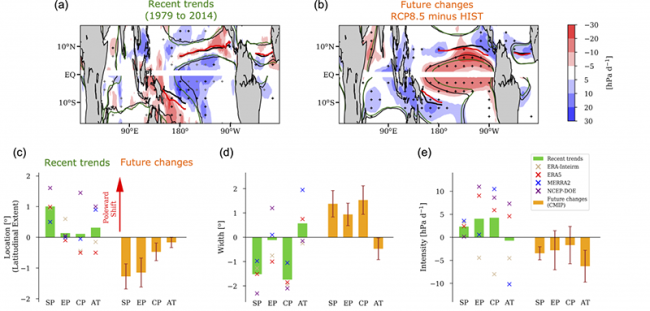Contrasting recent and future changes in the Intertropical Convergence Zone
The Intertropical Convergence Zone (ITCZ) is a planetary-scale band of rising air and intense rainfall that migrates seasonally around the equator. Under global warming, the ITCZ is projected to shift towards the equator, leading to squeeze in the annual-mean tropical ascent and far-reaching impacts on global circulation. It is unclear if the projected ITCZ changes have emerged in observations, and more importantly, what drives the ITCZ variability and changes. In a new Geophysical Research Letters paper, Zhou and coauthors research the observed and projected ITCZ changes based on a variety of observation and reanalysis datasets and ensemble projections of climate models. They found that the observed ITCZ changes in location, width, and intensity are largely opposite to the projected future changes due to the distinct tropical sea surface warming patterns.

Top: (a) Recent trends in the warm-season 500-hPa vertical velocity over 1979-2014. The boundaries of the seasonal ITCZs are denoted by the black and green contours for the first and last 10-years, respectively. The locations of the peak ascent are denoted by the black and red lines for the first and last 10-years. (b) Same as a but for the projected future changes. The boundaries and centers of the seasonal ITCZs are denoted for current (black contours and lines) and future (green contours and red lines) climate. (c-e) Changes in the location, width, and intensity of the seasonal ITCZs in the South Pacific (SP), eastern North Pacific (EP), central North Pacific (CP) and Atlantic (AT) over 1979-2014 (green bars; color crosses for individual reanalysis datasets) and projected under future warming (orange bars; intermodel s.d. indicated by error bars).
Unlike previous studies that focused on the annual-mean zonal-mean picture, this study looked into the seasonal and regional characteristics of the ITCZ, which prove essential for explaining the annual-mean zonal-mean changes. The ITCZ location, width, and intensity are defined based on the seasonal and regional band of the 500-hPa vertical velocity. Under future warming, the seasonal ITCZs are projected to shift equatorward, widen, and weaken over most ocean basins. Despite the widening of the seasonal ITCZs, the annual-mean tropical ascent squeezes due to the equatorward-shifted seasonal ITCZs. In contrast to the projected changes, the observed changes in the seasonal ITCZs over 1979-2014 feature a poleward shift in the South Pacific, narrowing in the central North Pacific and strengthening in the eastern North Pacific. With such distinct seasonal ITCZ changes, the observed annual-mean zonal-mean changes are largely opposite to the future squeeze.
The contrast in recently observed and projected ITCZ changes are attributed to the distinct tropical warming patterns. Specifically, the equatorial Pacific has cooled over 1979-2014 following a positive-to-negative phase change in the Pacific Decadal Oscillation (PDO), but in the future projection the equatorial Pacific would experience enhanced anthropogenic warming due to weaker evaporative damping and effects of ocean dynamics. The tropical warming pattern affects the ITCZ by modulating the seasonal warm-SST band (thermodynamically) and by influencing the atmospheric energetic flux and gross moist stability (energetically).
Overall, this study highlights the critical role of the tropical warming pattern in regulating the ITCZ variability and change. Just as the negative PDO phase in the recent decade masked the anthropogenically-forced changes, a PDO positive phase in the coming decades can act jointly with anthropogenically-forced equatorial warming, leading to substantial ITCZ changes that are opposite to recent trends. Such ITCZ changes will have profound impacts on global circulation, hydroclimate, and weather in ways that are unprecedented in historical observations.
Contrasting recent and future ITCZ changes from distinct tropical warming patterns (Geophysical Research Letters)
Topics
- Pacific Ocean
- Modeling
- Climate Change
- Internal Variability
